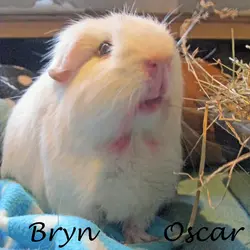My new boy I adopted today was brought into the rescue with bumblefoot. The rescue healed him, and altho his foot became a little deformed from the infection (not sure just how bad it was) he gets around well and he's all healed up. I read somewhere on the net (can't find where now) that bumblefoot can come back in some pigs. Is this true, and what are the chances of it happening? Is there anything in particular I can do to prevent it? He lives in a c&c cage with fleece, and I pick up poop 2x a day or more, and usually switch out bedding every few days. We do have a regular vet and the rescue invited me to alert them to any future bumblefoot issues and they'd help with treatment. If I'm allowed to post a link to facebook, this is him at the rescue -
Facebook
Hi!
It depends very much on what was causing the bumblefoot in the first place; whether it has got further into the foot or got into the bone; whether there are further underlying issues (like a weakened immune system) or later in life a weaker heart/blod circulation etc. Bumblefoot can return in some piggies, especially where the infection has not been fully healed out.
You can find some tips re. caring for guinea pigs at higher risk of bumblefoot in our mobility guide. Otherwise you have taken all reasonable precautions. Only time will tell. Because a lot depends what germs get into the open bumblefoot sores and how badly the feet are affected, there is no one surefire way of treating bumblefoot.
In well cared for piggies it is generally an old age problem, caused by decreased mobility and a less effective blood circulation. Moast cases in rescue piggies are sadly the result of neglect and inappropriate conditions.
I would recommend to concentrate on a good general grass hay based diet in order to gradually strengthen the immune system naturally from the gut outwards; this will boost the fight from within as well as chances for a normal good life span. This is a highly effective low level defence that often gets overlooked. Good general care without over-pampering but with plenty of enrichment is your best weapon - a happy, active life which helps to boost the natural defences that your piggy has. I have found that noticeably more of the piggies from horrible backgrounds that I have adopted have been able to live a normal life span or sometimes even beyond than not; your care really can make a big difference in those cases where there are no other underlying factors at play.
The other measure is to poo patrol and to change the bedding very regularly. Don't be tempted to cream the feet preventatively - soft skin can be more prone to infections than the naturally harder skin on the soles that guinea pig should have. Rather do an extra rinse with your fleece to wash out any remains of washing powder that could cause minor redness in the skin.
Looking after guinea pigs with limited or no mobility
Long Term Balanced General And Special Needs Guinea Pig Diets
Enrichment Ideas for Guinea Pigs
Guinea Lynx :: Pododermatitis
We can never control when and what from our piggies will die; but since guinea pigs don't measure their life in terms of an average life expectancy but in happy todays, you will never go wrong in making every day a happy one and celebrating every day you have with them so both you and your guinea pigs end up with a treasure care full of precious memories whatever happens. Pet ownership by its very nature is never about length but always about quality. We have our more short-lived pets only for part of our life and it all hinges of what we make out of this time span.
The piggy I can never remember but without a big smile plastered on my face lived with me only for a year; he was a widowed 5 years old neutered boar stuck in a rescue without interest - but Bryn Oscar (the name deaf) clearly had the best time of his life living life in the fast lane with my old ladies, squeezing through the tiniest crack in the grids to cause mayhem with my other boars and seducing any sow within sight before old age caught up with him.

I hope that this and the information in the links will help you?
